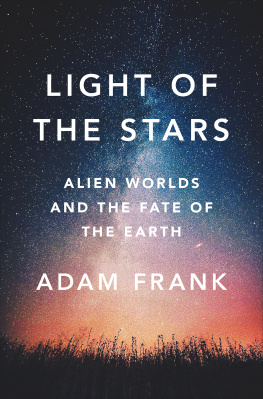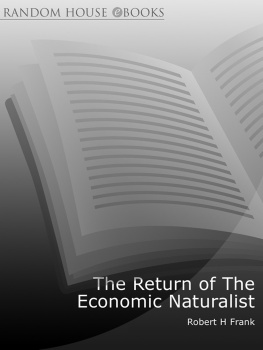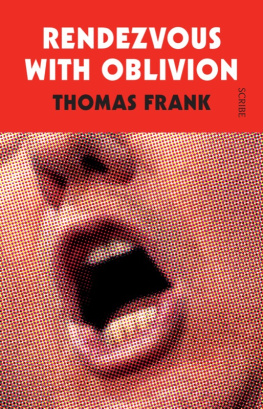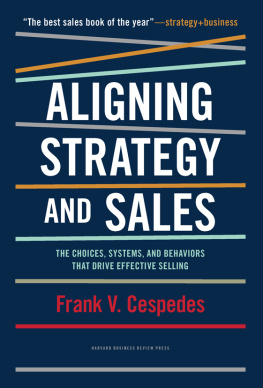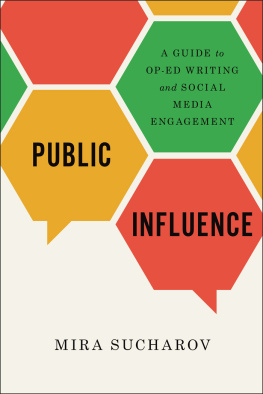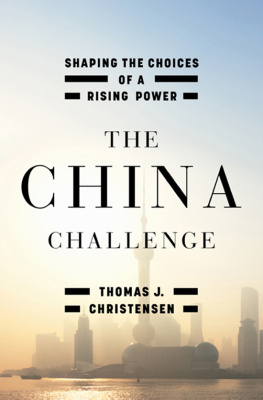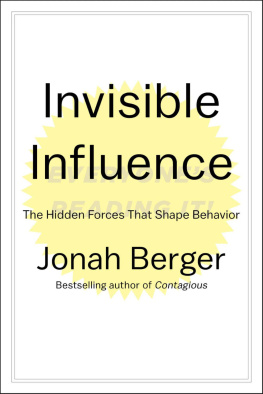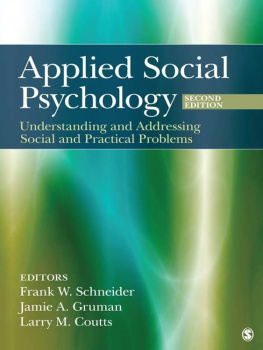FRANK - UNDER THE INFLUENCE : shaping the social forces that guide our choices.
Here you can read online FRANK - UNDER THE INFLUENCE : shaping the social forces that guide our choices. full text of the book (entire story) in english for free. Download pdf and epub, get meaning, cover and reviews about this ebook. City: S.l., year: 2020, publisher: PRINCETON UNIV PRESS, genre: Politics. Description of the work, (preface) as well as reviews are available. Best literature library LitArk.com created for fans of good reading and offers a wide selection of genres:
Romance novel
Science fiction
Adventure
Detective
Science
History
Home and family
Prose
Art
Politics
Computer
Non-fiction
Religion
Business
Children
Humor
Choose a favorite category and find really read worthwhile books. Enjoy immersion in the world of imagination, feel the emotions of the characters or learn something new for yourself, make an fascinating discovery.

UNDER THE INFLUENCE : shaping the social forces that guide our choices.: summary, description and annotation
We offer to read an annotation, description, summary or preface (depends on what the author of the book "UNDER THE INFLUENCE : shaping the social forces that guide our choices." wrote himself). If you haven't found the necessary information about the book — write in the comments, we will try to find it.
UNDER THE INFLUENCE : shaping the social forces that guide our choices. — read online for free the complete book (whole text) full work
Below is the text of the book, divided by pages. System saving the place of the last page read, allows you to conveniently read the book "UNDER THE INFLUENCE : shaping the social forces that guide our choices." online for free, without having to search again every time where you left off. Put a bookmark, and you can go to the page where you finished reading at any time.
Font size:
Interval:
Bookmark:
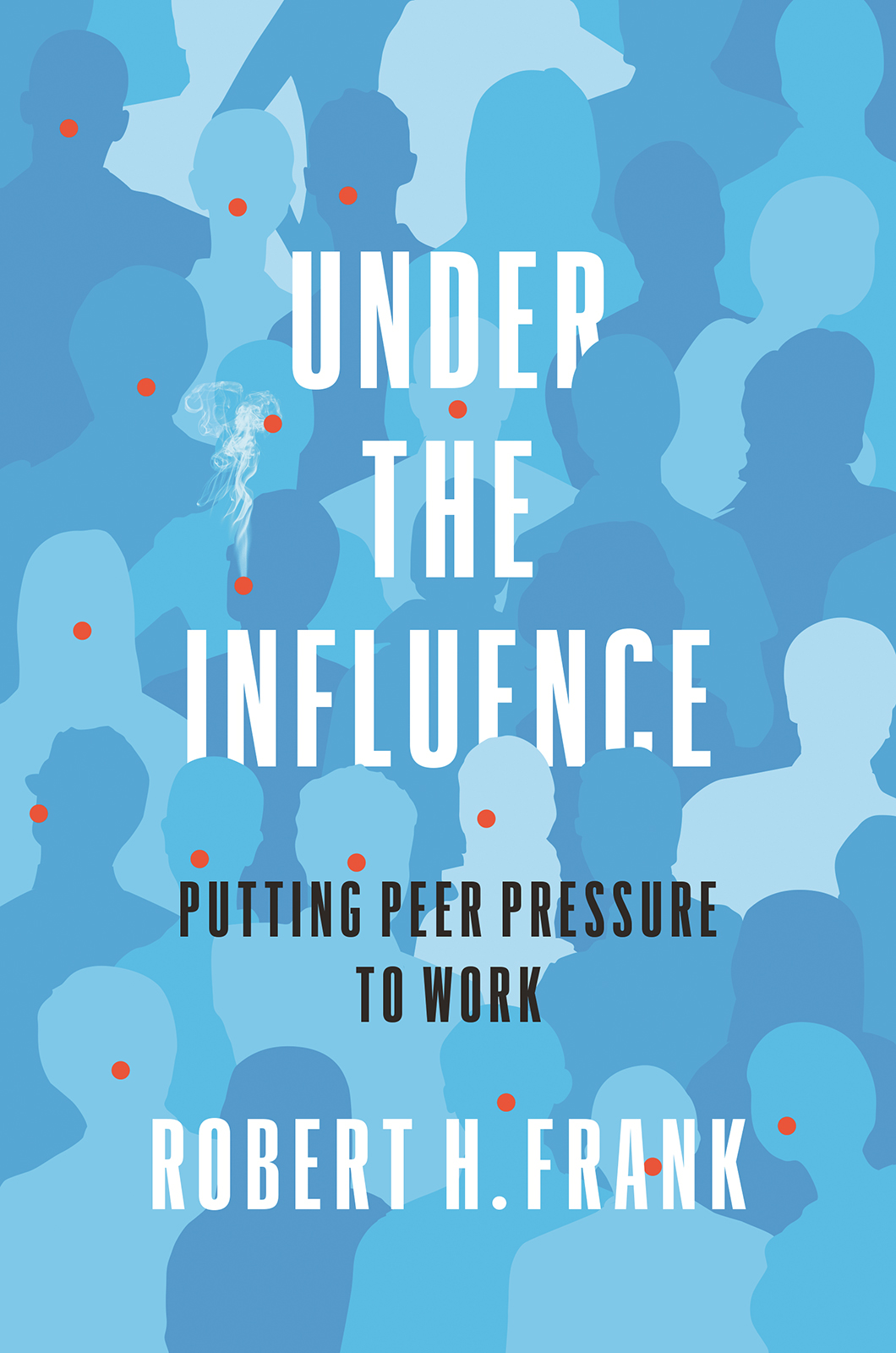
EBSCO Publishing : eBook Collection (EBSCOhost) - printed on 2/3/2020 11:04 AM via UNIVERSITY OF TECHNOLOGY SYDNEY
AN: 2218634 ; Robert H. Frank.; Under the Influence : Putting Peer Pressure to Work
Account: s4881343
Copyright 2020 by Robert H. Frank
Requests for permission to reproduce material from this work should be sent to
Published by Princeton University Press
41 William Street, Princeton, New Jersey 08540
6 Oxford Street, Woodstock, Oxfordshire OX20 1TR
press.princeton.edu
All Rights Reserved
ISBN 9780691193083
ISBN (e-book) 9780691198828
Version 1.0
British Library Cataloging-in-Publication Data is available
Editorial: Joe Jackson and Jacqueline Delaney
Production Editorial: Lauren Lepow
Jacket Design: Matt Avery (Monograph LLC)
Jacket art: iStock
Example, whether it be good or bad, has a powerful influence.
GEORGE WASHINGTON, MARCH 5, 1780
Introduction
That we are more closely connected to one another than most of us realize is an old idea. An important variation dates from 1929, when the Hungarian writer Frigyes Karinthy published a short story titled Lncszemek (Chains). Two of the storys main characters speculate that any two living people can be connected by a chain involving no more than five acquaintances. That some such chains exist is hardly surprising, since most of us can think of people in distant locations to whom we are connected through a small number of intermediaries. The man-bites-dog aspect of Karinthys conjecture is that almost any two people A and E could be linked by a chain like A knows B, who knows C, who knows D, who knows E.
One of the first systematic attempts to test this claim came in the 1960s with a series of experiments by the psychologist Stanley Milgram. In one, he sent packages containing a small booklet to ninety-six people chosen at random from the Omaha, Nebraska, telephone directory. His cover letter asked them to try to forward the booklet to a specific resident of Boston, Massachusetts, through a chain of personal acquaintances. He told them the name and address of the Boston resident, that he worked as a stockbroker, and that the first person in their chain should be someone they knew on a first-name basis. Milgram also advised them to choose someone they believed (presumably based on the targets location and occupation) could be socially closer to the target than they themselves were. Subsequent recipients in the chain were asked to forward the same instructions.
Many of the Omaha recipients undoubtedly tossed Milgrams booklet in the trash, so it is remarkable that the Boston target received eighteen of the ninety-six packages. The average number of links in the eighteen chains was 5.9. But the now-familiar expression six degrees of separation would not gain broad currency until many years later, when John Guares play by that name premiered on Broadway in 1990.
The concept became a meme in full when four Albright College students introduced Six Degrees of Kevin Bacon in 1994, a game designed to measure the professional proximity of an actor, living or dead, to the American film star Kevin Bacon. An actor has a Bacon number of 1, for example, if she or he appeared in the same film with Bacon. Someone who appeared in a film with another actor who appeared in a film with Bacon has a Bacon number of 2, and so on. The average Bacon number is 2.955 among actors who have one. In that group, even the actor most distant from Bacon, William Rufus Shafter, has a Bacon number of only 7. Shafter, a Union Army officer during the Civil War, appeared in two films in 1898.
For academics who study social connectedness, the six-degrees concept gained little traction until 1998. Thats when the sociologist Duncan Watts and the mathematician Steven Strogatz published their landmark paper, Collective Dynamics of Small-World Networks, in Nature. In the years since then, this paper has provided the mathematical foundation for the analytical tools that social scientists have been using with such remarkable success to study how ideas and behaviors spread through populations like infectious diseases. It has already been cited by other scholars more than thirty-eight thousand times and is one of the few papers ever published to be among the most widely cited works in multiple disciplines.
In his 1976 book, The Selfish Gene, the evolutionary biologist Richard Dawkins coined the term meme, which Webster now defines as an idea, behavior, style, or usage that spreads from person to person within a culture. The meme is to cultural transmission, Dawkins argued, as the gene is to biological transmission.
One of Charles Darwins central insights was that natural selection favors genetic variations that enhance the individual organisms ability to survive and reproduce. Much of the time, the same variations also benefit larger groups. But often not. For example, an inclination to cheat when no one is looking might benefit individuals, but widespread cheating almost always makes matters worse for groups. It is the same with memes. The memes that propagate most successfully are often ones that benefit both individuals and groups. But here, too, not always. As the legal scholar Jeffrey Stake has argued, Ideas should not be treated as inert products but as living things that sometimes exert some influence over their environment. Some of the ideas are more adept at surviving than others, and the ones that survive will not necessarily be good for humans.
It is often hard to evaluate whether a specific behavior even qualifies as a meme, and if so whether its consequences, on balance, are positive or negative. Yet sometimes the evidence is clear.
We know, for example, that the strongest predictor of whether people will take up smoking is the proportion of their close friends who smoke. Smoking is thus clearly a meme. The negative health consequences of smoking are also conclusively documented, and most smokers themselves express regret about having started. By definition, then, smoking unambiguously qualifies as a socially destructive meme.
On the other side of the ledger, we have compelling evidence that the adoption of photovoltaic solar panels is both socially contagious and almost uniformly positive in terms of environmental consequences. Accordingly, few would object to calling the practice a socially beneficial meme.
Adam Smith, widely considered the father of economics, is often cited in defense of the claim that competitive markets produce the greatest good for the greatest number. But that was never Smiths position. His signature insight was that the pursuit of narrow self-interest often leads to socially beneficial outcomes, but not always. The same holds for competition among ideas. Good ideas often triumph, but there is no presumption that the marketplace of ideas reliably promotes the common good, especially in the short run. My central claim in
Font size:
Interval:
Bookmark:
Similar books «UNDER THE INFLUENCE : shaping the social forces that guide our choices.»
Look at similar books to UNDER THE INFLUENCE : shaping the social forces that guide our choices.. We have selected literature similar in name and meaning in the hope of providing readers with more options to find new, interesting, not yet read works.
Discussion, reviews of the book UNDER THE INFLUENCE : shaping the social forces that guide our choices. and just readers' own opinions. Leave your comments, write what you think about the work, its meaning or the main characters. Specify what exactly you liked and what you didn't like, and why you think so.


